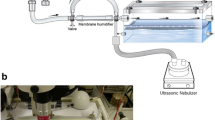Abstract
Objective
To test whether a reduction in air temperature within the clinical range [37 °C to 30, 100% relative humidity (RH)] altered mucus transport velocity (MTV) and ciliary beat frequency (CBF) in an in vitro ovine tracheal model.
Design
Controlled laboratory study.
Setting
University research laboratory.
Subjects
Farm-reared sheep.
Interventions
Tracheae were mounted flat in an organ bath. Krebs Henseleit bathed the serosal surface and air at 100% (RH) was passed over the mucosal surface at 4 l/min. Cilial beat frequency (CBF) was measured photo-electrically and mucus transport velocity (MTV) by timing movement. After 2 h at 37 °C (100% RH) the tissue was either maintained with those settings (controls), or the air temperature reduced to 34 °C or 30 °C. Tissue was taken for histology before and after each experiment.
Measurements and results
CBF was 19.8±2.7 beats/s and MTV 5.7±2.6 mm/min in tissue exposed to air at 37 °C. Cilial activity continued for up to 6 h in the controls but mucus transport was more fragile. Reduction of the air temperature to either 34 °C or 30 °C led to a decrease in both CBF and MTV and, frequently, total mucociliary failure. There was a reduction in epithelial mucous cell numbers in all preparations. Tissues exposed to low temperature had additional abnormal histology.
Conclusions
Delivery of inspired gas at 30 °C, or even 34 °C, with 100% RH may not be sufficient to prevent epithelial damage occurring during 6 h exposure.


Similar content being viewed by others
References
Williams R, Rankin N, Smith T, Galler D, Seakins P (1996) Relationship between the humidity and temperature of inspired gas and the function of the airway mucosa. Crit Care Med 24:1920–1929
Wills PJ, Pritchard K, Cole PJ (1998) Mucus transportability: the bovine trachea and frog palate models compared. Eur Respir J 12:837–841
Horstmann G, Iravani J, Norris MG, Richter H (1977) Influence of temperature and decreased water content of inspired air on the ciliated bronchial epithelium. A physiological and electron microscopical study. Acta Otolaryngol 84:124–131
Mercke U (1975) The influence of varying air humidity on mucociliary activity. Acta Otolaryngol 79:133–139
Stanek A, Brambrink A, Latorre F, Bender B, Kleemann P (1998) Effects of normobaric oxygen on ciliary beat frequency of human respiratory epithelium. Br J Anaesth 80:660–664
Seybold Z, Mariassy A, Stroh D, Kim C, Gazeroglu H, Wanner A (1990) Mucociliary interaction in vitro: effects of physiological and inflammatory stimuli. J Appl Physiol 68:1421–1426
Asmundsson T, Kilburn K (1970) Mucociliary clearance rates at various levels in dog lungs. Am Rev Respir Dis 102:388–397
Hirsch J, Tokayer J, Robinson M, Sackner M (1975) Effects of dry air and subsequent humidification on tracheal mucous velocity in dogs. J Appl Physiol 39:242–246
AARC Clinical Practice Guideline (1992) Humidification during mechanical ventilation. Respir Care 37:887–890
ISO 8185:1997 (1997) Humidifiers for medical use – General requirements for humidification systems. International Organisation for Standardisation
Ryan SN, Rankin N, Meyer E, Williams R (2002) Energy balance in the intubated human airway is an indicator of optimal gas conditioning. Crit Care Med 30:355–361
Alagar R, Garuccio J, Kudlak J, Nolder K (2000) Heated humidification reduces saline instillations, nebulized therapy, and cost in long-term ventilated patients. Am J Respir Crit Care Med 161:A552
Konrad F, Schiener R, Marx T, Georgieff M (1995) Ultrastructure and mucociliary transport of bronchial respiratory epithelium in intubated patients. Intensive Care Med 21:482–489
Author information
Authors and Affiliations
Corresponding author
Additional information
Work performed at the Institute of Food, Nutrition and Human Health, Massey University. The study was supported by a grant from Fisher & Paykel Healthcare. This work was presented in part as an abstract at the 2001 International Conference of the American Thoracic Society
Rights and permissions
About this article
Cite this article
Kilgour, E., Rankin, N., Ryan, S. et al. Mucociliary function deteriorates in the clinical range of inspired air temperature and humidity. Intensive Care Med 30, 1491–1494 (2004). https://doi.org/10.1007/s00134-004-2235-3
Received:
Accepted:
Published:
Issue Date:
DOI: https://doi.org/10.1007/s00134-004-2235-3




